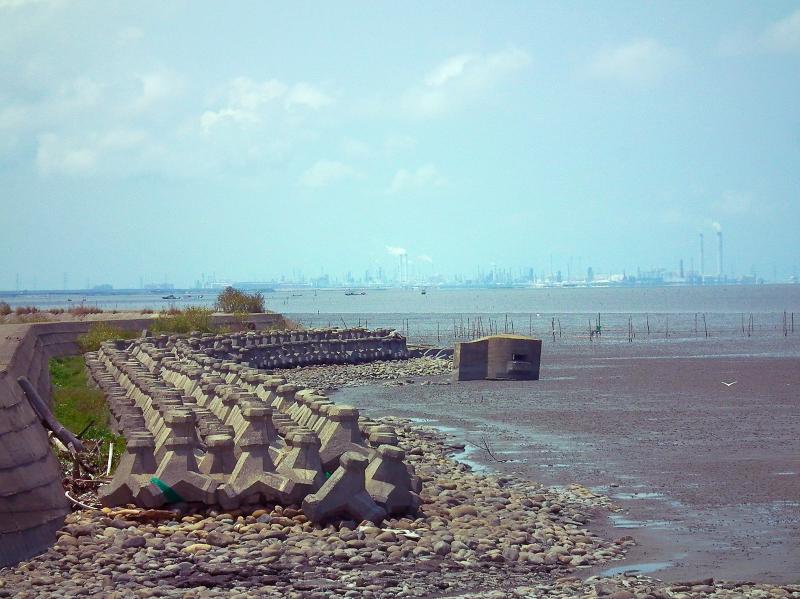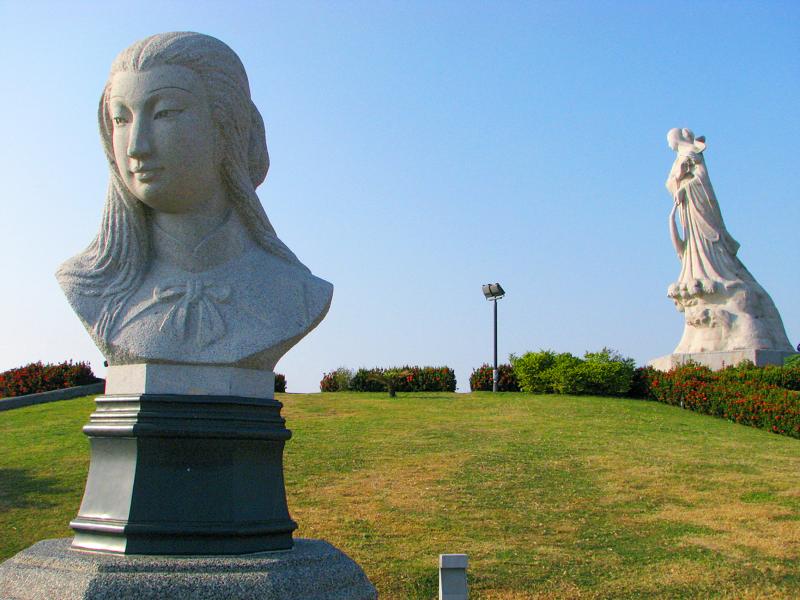Several years ago I was involved in a travel show that paid a visit to Wuling Farm (武陵農場), a lovely tourist spot high up in the central mountains, famous for hosting a small population of the Formosan landlocked salmon, one of the world’s rarest fish. We had missed the cherry blossoms, another attraction of the farm, and I queried our guide, a farm official, about the effect of climate change on the blossom schedule. He shook his head. “Everything has become unpredictable.”
This unpredictability is at the heart of the paradoxes of human warming of the earth: its effects are at once inevitable and uncertain, straightforward and variegated, local and global. Yet there is one constant in all this change: the changing sea.
Scary prospect for an island nation.

Photo: Michael Turton
Heating the earth has three major effects on the ocean: sea level rise, increased ocean temperatures, and ocean acidification. The first two are widely known to the public, but the third, just as devastating, is often left out of major media presentations.
Sea level rise is the most familiar to the public. Depending on which path humans take to ameliorate greenhouse gas outputs, the oceans will rise at least 0.3 to 1 meter by the end of the century (remember, sea level rises don’t stop in 2100, only the calculations do).
Of course Taiwan will suffer from this. According to a recent paper from Chiu Ming-chih (丘明智), Pan Ching-wen (潘靖汶) and Lin Hsing-juh (林幸助), by 2039, the sea level will rise over 3cm all around Taiwan, the ocean surface temperature will rise around 0.7 degrees Celcius, and the pH of coast waters will fall by 0.05 to 0.07. These changes will have powerful effects on coastal ecosystems that many Taiwanese depend on for incomes and leisure.

Photo: Michael Turton
SEA LEVEL RISE
Certain parts of Taiwan are especially vulnerable to sea level rise. In Yunlin County, for example, there are over 100,000 wells, “more than 90 percent of which were dug without confirming water rights or applying for permission to build hydraulic facilities, as required by the Irrigation Act,” a commentary on them several years ago noted.
This frenetic groundwater pumping for agriculture and aquaculture has caused massive subsidence along the south-central coast of Taiwan, up to a meter every five years near the coast. Because of this, sea level rises will top 5cm by 2039 along the south-central coast, according to a recent study. This will cause waves driven by storm surges to rise an average of nearly 36 percent, with large rises in maximum deviations from this average.

Photo: Michael Turton
Essentially, the waters will rise in predictable ways, and the nasty waves will get nastier, in less predictable ways. The result, according to the study, will be that seawalls will be overtopped, though not seriously in this period, especially in Wuqi (梧棲), Lukang (鹿港), Mailiao (麥寮), and Taisi (台西) townships.
Mailiao is the site of the massive oil refinery on reclaimed land jutting out into the ocean, while Wuqi and Lukang are ports with significant tourism.
Southwestern Taiwan is just as vulnerable. For years the center of the island’s aquaculture industry (in its heyday in the 1990s, 1.5 percent of the island’s land area was given over to aquaculture), groundwater extraction has caused widespread subsidence. Typhoon Morakot in 2009 threw a spotlight on the problem with its massive flooding, but climate change will inexorably result in greater frequency of flooding and eventual drowning of much of the area near the sea if nothing is done.
But again, this sea level rise doesn’t stop in 2100 when the calculations do. Taiwan’s coastal flooding problems will only worsen as time goes on.
Flooding is just one effect — as the rising ocean reshapes Taiwan’s coastline, it also reshapes the invasion risk from China. One expert I talked to pointed out that higher sea levels will require reconstruction and raising of sea walls. This will compel closer civil-military cooperation in construction.
“Breakwater projects in areas like Linyuan Beach near Kaohsiung Airport and farther south around Fangliao (枋寮), for example, have already made them a much tougher target for amphibious landings,” he said.
It goes without saying that like the naval bases of every other nation, Taiwan’s ports and naval bases will eventually have to be reconstructed or relocated as the ocean consumes them.
OCEAN HEATING AND ACIDIFICATION
Then there is ocean heating. As humans cook the oceans, Taiwan will face food security issues. According to a study by Japanese and Taiwanese scholars, ocean heating is already affecting Taiwan’s fish catch. Accelerated sea surface warming has reduced the catch of winter and spring fish, meaning that spring and autumn fish are now the dominant take. The 20 degrees centigrade line in the Taiwan Strait in the winter has shifted in latitude from around 23 degrees north in 1958 to north of 25 degrees north in 1998. It will continue to move north, pushing cold water fish further north.
Coastal and offshore fisheries account for just under 20 percent of Taiwan’s total seafood supply, with imports supplying the bulk (a share that is growing over time). Taiwan’s distant-water fishing fleet exports almost all of its catch, bringing back just over 5 percent of Taiwan’s seafood supply. Since seafood accounts for 37 percent of the animal protein intake of Taiwanese, it follows that the changing ocean will mean greater food insecurity for Taiwan, which is dependent on imports for most of its food (recall that much animal feed is imported as well).
Moreover, as the aforementioned study points out, among the major seafood exporters to Taiwan are China, India, Vietnam, Thailand, Indonesia, and Chile, all located in the hot zone where warming will have powerfully negative effects on local fish catches.
The heating ocean will also bring us devastating storms whose effects on trade and tourism are at present difficult to foresee. But they will not be good for an island dependent on trade.
Intensifying the effects of warming is ocean acidification. Carbon dioxide produced by humans interacts with sea water to form carbonic acid, some of which disassociates to form bicarbonate and hydrogen ions, slowly making the oceans more acidic. Acidification reduces the ability of shellfish and other organisms that make calcium carbonate shells to form shells. Ocean acidification has already been linked to at least one mass extinction event in the planet’s history.
Scholarly work in Australian waters shows that the impact of acidification will be greatest in areas that are already intensively fished. Such areas supply Taiwan with seafood for both home and export uses. It will also clobber Taiwan’s coastal ecosystems.
“For most of history, man has had to fight nature to survive; in this century he is beginning to realize that, in order to survive, he must protect it,” remarked famed oceanic explorer Jacques-Yves Cousteau. It is easy to dismiss Taiwan as a mere pebble in the path of a flood, but as the island nation’s remarkable performance in reining in COVID-19 shows, our little island has the potential for outsized global impact on urgent international issues. Time to turn our experts loose on the island’s intolerable levels of carbon production, and show the world that Taiwan can lead on that issue as well.
Because just off our shores, a monster is rising.
Long-time resident Michael Turton provides incisive commentary informed by three decades of living in and writing about Taiwan.

In 1990, Amy Chen (陳怡美) was beginning third grade in Calhoun County, Texas, as the youngest of six and the only one in her family of Taiwanese immigrants to be born in the US. She recalls, “my father gave me a stack of typed manuscript pages and a pen and asked me to find typos, missing punctuation, and extra spaces.” The manuscript was for an English-learning book to be sold in Taiwan. “I was copy editing as a child,” she says. Now a 42-year-old freelance writer in Santa Barbara, California, Amy Chen has only recently realized that her father, Chen Po-jung (陳伯榕), who

Famed Chinese demographer Yi Fuxian (易富賢) recently wrote for The Diplomat on the effects of a cross-strait war on demography. He contended that one way to deter the People’s Republic of China (PRC) is by putting the demographic issue front and center — last year total births in the PRC, he said, receded to levels not seen since 1762. Yi observes that Taiwan’s current fertility rate is already lower than Ukraine’s — a nation at war that is refusing to send its young into battle — and that its “demographic crisis suggests that Taiwan’s technological importance will rapidly decline, and

Jan. 6 to Jan. 12 Perhaps hoping to gain the blessing of the stone-age hunter-gatherers that dwelt along the east coast 30,000 years ago, visitors to the Baxian Caves (八仙洞) during the 1970s would grab a handful of soil to bring home. In January 1969, the nation was captivated by the excavation of pre-ceramic artifacts and other traces of human habitation in several caves atop a sea cliff in Taitung County. The majority of the unearthed objects were single-faced, unpolished flake tools fashioned from natural pebbles collected by the shore. While archaeologists had found plenty of neolithic (7,000 BC to 1,700

When the weather is too cold to enjoy the white beaches and blue waters of Pingtung County’s Kenting (墾丁), it’s the perfect time to head up into the hills and enjoy a different part of the national park. In the highlands above the bustling beach resorts, a simple set of trails treats visitors to lush forest, rocky peaks, billowing grassland and a spectacular bird’s-eye view of the coast. The rolling hills beyond Hengchun Township (恆春) in Pingtung County offer a two-hour through-hike of sweeping views from the mighty peak of Dajianshih Mountain (大尖石山) to Eluanbi Lighthouse (鵝鑾鼻燈塔) on the coast, or